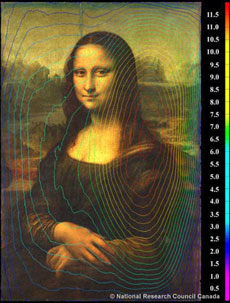OTTAWA - Mona Lisa, the mysterious woman immortalized in Leonardo da
Vinci's 16th century masterpiece, had just given birth to her second son when
she sat for the painting, a French art expert said on Tuesday.
The discovery was made by a team of Canadian scientists who used special
infrared and three-dimensional technology to peer through hitherto impenetrable
paint layers on the work, which now sits in the Louvre museum in Paris.

A color-coded
elevation contour map of the Mona Lisa is seen in this undated handout
image. The Mona Lisa, Leonardo da Vinci's 16th century masterpiece, is in
fragile condition but should not suffer too much damage if taken care of
properly, experts who studied the painting closely said on Tuesday.
[Reuters] |
Bruno Mottin of the French Museums'
Centre for Research and Restoration said that on very close examination of the
painting it became clear that the Mona Lisa's dress was covered in a thin
transparent gauze veil.
"This type of gauze dress ... was typical of the kind worn in early 16th
century Italy by women who were pregnant or who had just given birth. This is
something that had never been seen up to now because the painting was always
judged to be dark and difficult to examine," he told a news conference.
"We can now say that this painting by Leonardo da Vinci was painted to
commemorate the birth of the second son of the Mona Lisa, which helps us to date
it more precisely to around 1503."
The young woman with the ambiguous half smile has been identified as Lisa
Gherardini, wife of Florentine merchant Francesco de Giocondo. She had five
children.
Mottin also said that, contrary to popular belief, the subject had not let
her hair hang freely but in fact wore a bonnet from which only a few curls
managed to escape.
"People always wrote that the Mona Lisa had allowed her hair to hang freely
over her shoulders. This greatly surprised historians because letting your hair
hang freely during the Renaissance was typical of young girls and women of poor
virtue," he said.
The experts from Canada's National Research Council said the painting was in
fragile condition but should not suffer too much damage if taken care of
properly.
"The wood panel on which the Mona Lisa is painted is sensitive to temperature
and climate variations. However, if its current storage conditions are
maintained, there is no risk of degradation," the NRC said in a statement.
"The 12 cm (3-1/2 inch) split on the top half of the painting, which was
probably due to the removal of the original frame and repaired between the
middle of the 18th and beginning of the 19th century, appears to be stable and
has not worsened over time."
The council had hoped to discover more details about Leonardo's "sfumato"
technique of subtly blending one tone into another, which the artist used to
create a hazy effect. But scientist John Taylor said the team had been
frustrated by the lack of brush stroke detail on the painting.
"It's extremely thinly painted and extremely flat, and yet the details of the
curls of hair, for example are extremely distinct. So the technique is unlike
anything we've ever seen before. Leonardo was in a league of his own," he said.
Close examination of the craquelure -- the fine pattern of cracks formed on
old paintings -- showed the paint layers were still firmly attached to the
poplar wood panel on which Leonardo created his masterpiece.
"We didn't see any sign of paint lifting. So for a 500-year-old painting it's
very good news. And if they continue to keep it the way they have in an
environment-controlled chamber, it could remain like that for a very long time,"
Taylor said.